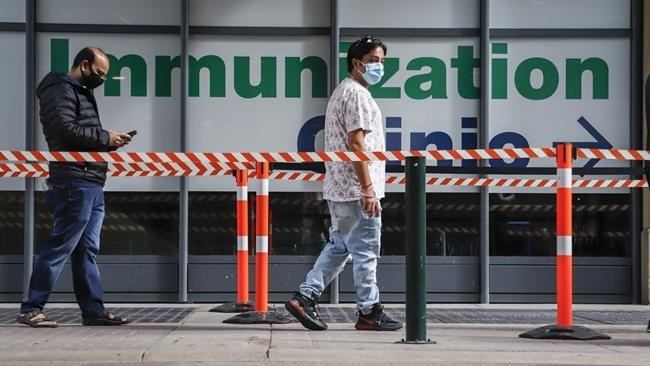
Albertans line-up for a COVID-19 vaccination at a mass immunization clinic in downtown Calgary, Alta., Monday, May 17, 2021. THE CANADIAN PRESS/Jeff McIntosh
October 21, 2021 - 11:02 AM
Kelly Grindrod remembers the confusion pharmacists felt last spring as Canada's COVID-19 vaccine policy changed rapidly throughout the rollout, sometimes with little warning.
Shifting eligibility requirements differed across the country, booking sites were harder to navigate in some regions, and one vaccine product came to be seen as inferior to the rest, infuriating the public and vaccinators alike.
Grindrod, an associate professor at the University of Waterloo and the pharmacy lead for Waterloo Region's vaccine rollout, hopes provinces learned lessons from Canada's first vaccination campaign for adults.
And if a COVID-19 vaccine is soon approved for children, she said a kid's rollout needs consistent and clear messaging.
"Communication was a real challenge," Grindrod recalled. "(Policy) would be announced nationally and everybody on the ground had to scramble because we were all hearing it at the same time.
"Immediately the phones would go crazy in pharmacies because people were trying to make sense of it.... We need a bit more lead-in, a bit more clarity, so (vaccinators) have answers before people start calling."
Pfizer-BioNTech asked Health Canada to authorize its COVID-19 vaccine for kids aged five-to-11 this week. The regulator is reviewing data before making a decision.
Prime Minister Justin Trudeau said Thursday that Pfizer is ready to ship millions of child doses in the event of authorization, while Public Services and Procurement Minister Anita Anand added that Canada has already procured syringes and other supplies needed to speed up the rollout.
In the United States,an advisory group with the Food and Drug Administration, which received an approval request from Pfizer earlier this month, is scheduled to meet next week. The Centers for Disease Control and Prevention is then set to discuss authorization in early November.
Grindrod said U.S. regulators, which sometimes stream meetings online, have shown "more transparency around the (decision-making) process."
Health Canada and the National Advisory Committee on Immunization supply "fairly comprehensive" documents after they've made decisions, she said, but vaccinators could use a heads up "to facilitate planning."
Logistics of the kids rollout — where children get a vaccine, how they book appointments and whether certain kids will be prioritized — are still to be determined. Ontario said Tuesday it was open to running mass vaccine clinics at schools after school hours.
Omar Khan, an immunology and infectious disease expert with the University of Toronto, said school clinics are a great way to reach more kids. Pharmacies and family doctors can also help, but proper scheduling — which includes flexibility around parents' work hours — is needed to ensure half-empty vaccine vials aren't tossed at the end of the day.
"Anything that reduces accessibility barriers will help distribute (vaccines) to the queue of people waiting to get vaccinated across multiple sites," he said.
Most logistics can be ironed out once supply is determined, Grindrod said.
Pfizer's pediatric vaccine involves a different formulation, but Grindrod said some pharmacists have asked whether they must wait for kid-specific shipments or if a diluted adult dose could serve if supply was scarce. She urged clear information as soon as possible.
Messaging around the kids vaccine in general has to be handled with more care, she said,starting with whatever NACI and Health Canada recommend after reviewing its safety and efficacy.
"We need very careful communication ... because we haven't seen the data," she said. "There are questions that need to be answered very clearly — what is the risk of COVID to kids at the point at which vaccines become available? What are the known side effects we expect to see based on data from trials?
"And then separately, what are the unknowns?"
Science communicator Samantha Yammine noted the difficulty in maintaining consistent vaccine advice when the science on COVID-19 evolved quickly throughout the pandemic.
Policies introduced midway through the adult rollout, such as NACI's recommendation against using AstraZeneca for second doses, seemed to contradict earlier advice. But public health messaging constantly adapts to new data, she said.
While communication was confusing at times, the country still vaccinated nearly 82 per cent of its eligible population to date.
Since parents are likely more concerned about vaccinating children than getting the jab themselves, fears should be addressed honestly and parents made to feel part of the plan, Yammine said.
That includes equipping parents with child-friendly information they may need to field youngsters' questions about the vaccine, she added.
And kids' comprehension level shouldn't be underestimated.
"I'm advising people to acknowledge how great a job kids have done," Yammine said. "Wearing masks, understanding why they have to play with friends outside, it's been really hard on kids.
"But they've shown us they can be involved and they can understand complex things."
This report by The Canadian Press was first published Oct. 21, 2021.
News from © The Canadian Press, 2021